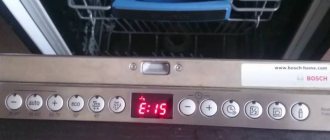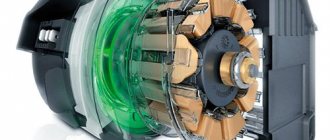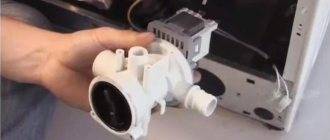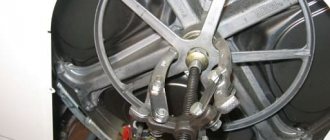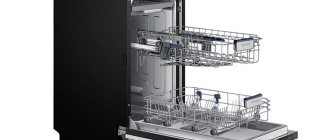Types of heating elements
The main problem with the heating element for a Bosch brand dishwasher is frequent overheating. This phenomenon is associated with growing layers of scale. This situation is inherent in a tubular electric heater, especially if specialized salt is not added to the softening water.
Flow type water heater (heater)
Bosch dishwasher heating elements can be:
- Submersible or so-called wet. Such a heating element has direct contact with the liquid and directly heats it.
- Dry, which are surrounded by a soapstone flask for protection.
Experts consider dry heaters to be more efficient. Due to the lack of direct contact with the working fluid, they can last much longer. A wide flask promotes rapid heating of water and the formation of less scale. Among other things, the dry heating element protects the dishwasher from dry plugs, and is quite easily dismantled for replacement with a new one.
Types of heating element in a dishwasher
Bosch, Ariston, Electrolux, and Candy dishwasher models contain two types of heating elements:
- Flowing or dry.
- Tubular with a spiral, or wet.
The first type is connected to the pump and pipe. Water is driven through its tube by a motor, so it heats up instantly. Such parts are less susceptible to scale and therefore have a long service life.
The second, submersible, element is combined with a circulation pump. Since it is constantly in water, it is more susceptible to scale deposits. Over time, the amount of salts on the surface interferes with normal heat transfer, causing the element to overheat and burn.
How do you know if the heater is broken and it’s time to replace it? Typical symptoms of a problem are described below.
Types of heating element in a dishwasher
Bosch, Ariston, Electrolux, and Candy dishwasher models contain two types of heating elements:
- Flowing or dry.
- Tubular with a spiral, or wet.
The first type is connected to the pump and pipe. Water is driven through its tube by a motor, so it heats up instantly. Such parts are less susceptible to scale and therefore have a long service life.
The second, submersible, element is combined with a circulation pump. Since it is constantly in water, it is more susceptible to scale deposits. Over time, the amount of salts on the surface interferes with normal heat transfer, causing the element to overheat and burn.
How do you know if the heater is broken and it’s time to replace it? Typical symptoms of a problem are described below.
Design and principle of operation
A heating element is an electrical device that heats liquid with a built-in spiral made of a special material. The conductive element is located in a sealed tube, which is isolated from the machine body. The heater is placed in a water jacket, and an electric vane pump is used to circulate the liquid. The joint line between the parts is sealed with a rubber gasket, which prevents water from entering the contact elements.
When an electric current passes through the coil, heat is released; measuring sensors are used to adjust the operation of the heater. The sensor controls the set temperature; when the required value is reached, the heater turns off. As soon as the water cools below the programmed threshold, the power supply is restored. Bosch tubular heaters installed in machines manufactured after 2010 are equipped with an additional pump that improves fluid circulation and accelerates heat transfer.
Bosch produces flow-through heaters with a tubular element in direct contact with the water flow.
On some modifications of dishwashers, there are dry-type units, distinguished by the installation of a heating tube in a separate housing. The gap between the walls is filled with a thermally stable compound, which further insulates the electrical components from water.
Internal organization
All spare parts and control elements are installed inside the bosch dishwasher body. The main details of this system are:
- A flow valve for water intake, which is equipped with an inlet system, controlled by a microcontroller.
- A filtration mechanism that cleans water from small parts of food and other debris.
- A drainage system consisting of a drainage pipe connected to a drainage system and a sump pump. It works on the same principles as the Bosch washing machine.
- Float-type blocker, protective system of the dishwasher from various leaks. It is a cylindrical plastic container that closes contacts when floating up. This happens when too much water is taken.
Signs of malfunction. How to check the heating element?
The problem can be determined by indirect signs. Also, modern PMMs report a problem by displaying an error code on the display. Almost all Hotpoint Ariston, Indesit, Siemens models are equipped with a self-diagnosis system. If there is a problem, a test mode is launched, as a result of which all nodes are tested.
An additional sign is poor dishwashing. If previously the dishwasher washed the utensils normally, but now a greasy residue remains on the surfaces, the problem is probably in the heating element.
Where is the element? It is located at the bottom of the housing, near the engine and pump. First, you can inspect the condition of the temperature sensor. It directly determines whether the heater will turn on or not.
- Disconnect the device from the network and communications.
- Place a towel on the floor and place the car on its side.
- Remove the base panel.
- Inspect the thermistor and its wiring. If traces of scorch are visible, replace the part.
- To diagnose the heating element, apply the multimeter probes to the contacts to measure the resistance.
- A working part will show values around 22 ohms.
If it turns out that the element has failed, a complete replacement is carried out.
What indicates a breakdown
Signs of failure of the heater and elements associated with the device:
- displaying an error code containing the numbers 09 on the liquid crystal display;
- supply of overheated or cold water due to a breakdown of the thermal regulator;
- the appearance of voltage on the surface of the housing due to breakdown of the heating element;
- extraneous noise that occurs when the built-in pump wears out or breaks down.
Signs and causes of heating element failure
There are indirect reasons for determining problems with a tubular electric heater. Some modern dishwasher models notify owners of problems through an error indicator on the screen. The following models are equipped with a comprehensive automatic diagnostic program:
- Hotpoint Ariston;
- Indesit;
- Siemens.
Causes of heating device failure
Important! A problem with the heating element can occur when the dishwasher becomes less efficient at cleaning dishes and greasy stains remain on them.
Dishwasher users are forced to change the electric heater due to a burnt-out spiral part and an electrical short in the lower part of the pipes. Most often, flow-through heating elements become unusable.
The following reasons for electric heater failure are identified:
- there is a leak;
- a sharp surge in voltage in the electrical supply network;
- dirty filter;
- incorrect operating conditions for the dishwasher;
- wear and accumulation of at least two millimeters of scale on the element.
Ten in the dishwasher
Important! For constant unstable surges, a voltage stabilizer should be installed. And carefully study the operating instructions for household appliances before using them.
Step-by-step instructions for replacing the heating element
Have you decided to replace a faulty heating element in your dishwasher yourself?
Prepare the following set of necessary tools:
- 2 screwdrivers – flat and Phillips;
- screwdriver;
- multimeter or ohmmeter;
- pliers and awl.
The algorithm for independently replacing an electric heating element is as follows.
Main process
To make the entire technology for replacing heating elements in a dishwasher clear to you, we will provide it in the form of step-by-step instructions. Please note that different models of equipment may have slightly different fastenings, but in general the disassembly sequence is approximately the same.
So, all the work consists of the following 10 stages:
- Unplug the dishwasher and disconnect the water supply hose and drain.
- Open the door and remove the dish trays so that they do not interfere with replacement later.
- Remove the spray arm that is installed at the bottom of the dishwasher. To do this, pull the spray arm up.
- Unscrew the filter installed under the sprinkler and immediately remove the stainless steel mesh.
- Unscrew the screws that hold the pipe and the heating block itself.
- Turn the dishwasher upside down and provide access to the heating element. If the dishwasher is free-standing, you need to remove the back wall; if it is built-in, you need to remove the bottom panel.
- Remove the pump. This is quite simple to do - you just need to unscrew it clockwise and pull it to the side. Everything is done without much effort. Don't forget to disconnect the sensor, clamp and pipe.
- Reach under the body and remove the rubber fasteners holding the heating element, as well as the hose.
- Carefully remove the inoperative heater.
- Replace the heating element with a new one and reassemble the dishwasher in the reverse order.
Replacing the heating element
Before replacing the heating element of the dishwasher, you will need to disconnect the connection hose connected to the water supply line and disconnect the hose for draining the waste liquid into the sewer. Disassembly of the housing and replacement of components is carried out only with the equipment de-energized. To complete the job, you will need a set of Phillips and flathead screwdrivers, a test tool, pliers and a set of wrenches or sockets.
Sequence of actions when replacing the heater on a Bosch machine:
- Open the front door of the machine and remove the dish trays from the washing chamber.
- Remove the plastic liquid spray arms and remove the filter block from the seat on the bottom of the chamber.
- If the machine is built into a kitchen unit, then you need to unscrew the fastening screws on the sides and the housing lid.
- Pull up the lower spray arm, which is held in the landing channel by a retainer with a spring.
- Remove the plastic pipe connected to the heater (located in the cavity of the washing chamber).
- Move the dishwasher out into the open and remove the side covers. On built-in appliances, it is enough to lift the soundproofing panels and remove the plastic shields.
- Place the equipment on the back wall, having previously placed a layer of damping material.
- Remove the lower housing with adjustable feet, and then disconnect the water hose from the heater block. When the main line is turned off, the remaining water inside the hose and pump flows out. Sticky hoses are removed with pliers; applying force is prohibited due to the risk of breaking the pipes.
- Disconnect the connection cables and unscrew the screws or bolts (depending on the modification) securing the heater body. To hold electrical cords, plastic fasteners are used, which are removed with wire cutters or unfastened with an awl.
- After installing the new heater, assembly is performed in the reverse order.
- Test the operation of equipment in various modes.
Conclusions and useful video on the topic
Video material from a professional technician working in the service department of the Bosch dishwasher manufacturer.
The sequence of replacing the heating element, a detailed explanation of the nuances of operation. Tips on the practical use of heating elements applicable to specific modifications of dishwashers.
The heating system of the heating element is located in the dishwasher at a close distance to other control units. Because of this fact, replacing it or the entire pump + heater unit seems like a troublesome and difficult task. But if you follow the instructions, the repair will be successful and safe.
The main condition for replacement is strict adherence to the sequence of dismantling the inoperative machine unit and care when installing a new element.
